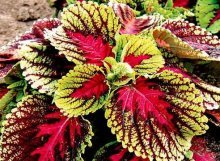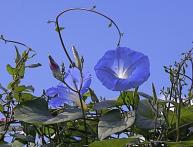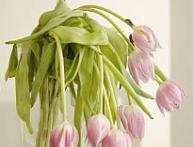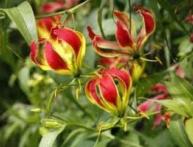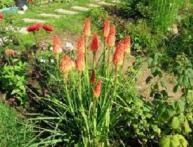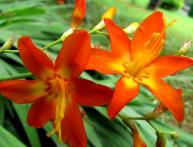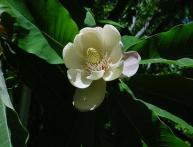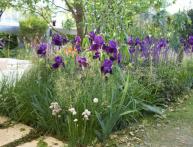Coleus bloome and features of its cultivation
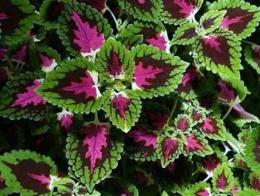
Coleus is a very bright ornamental plant. Its main feature is that the leaves are of greater decorative value than the flowers. Coleus has bright, colorful, velvety leaves. The plant is more commonly seen at home, but it also gets along well in the garden.
Content:
Where did Coleus come from?
Coleus is a perennial plant that belongs to the family Lamiaceae or Lamiaceae. In Western countries, Coleus in the scientific world is considered a genus of Solenostemon, but in everyday life the name is more familiar to everyone.
The flower came to us from the countries of southern and southeastern Asia, Australia and Africa. Coleus came to Europe from Indonesia. The very first to spread were two types of coleus: Blume and Verschaffelta. Over time, 18 more species appeared, but despite this, only the first two species are most often used for breeding hybrids.
They talk about coleus, you can hear the name “poor man's croton”, these two plants have similar leaf colors. The patterns on the leaves come in a wide variety of colors, ranging from light green to purple and maroon. The middle of the sheet is painted in one color, and the edge is framed in a contrasting color. Sometimes there are three colors at once, for example, green, burgundy and crimson.
Coleus stem fleshy, but over time it can become woody.The height of the plant ranges from 10 to 80 cm, it is impossible to guess to what extent a certain representative will grow, it all depends on the conditions and care. The leaves, depending on the species, can have jagged edges, elongated, oval and heart-shaped.
Although coleus came to us from tropical countries, it is easy to care for and does not require full climatic conditions. The subshrub is characterized by active growth and loves light.
Variety of types and varieties of coleus

There are more than 150 different types of coleus. Some are evergreen, some are annual, half of the representatives are herbaceous plants, the rest are subshrubs. The leaves have different colors, all have petioles.
flowering plant, but its flowers are hardly noticeable against the background of such variegated leaves, the inflorescences are spike-shaped. For example, Coleus bloome is a deciduous ornamental plant. Coleus bloome was first discovered on the island of Java. Most hybrids are bred from it. The height of the plant ranges from 40 to 70 cm, but there are also stunted representatives. Externally, the leaves are similar to nettle leaves. The leaves are so bright that it is difficult to pick out the primary colors. There are both single-color and multi-colored forms.
Variety of varieties of Coleus bloome:
- Volcano
- Butterfly
- Saber
- Milky Way Coleus pumilus
- The Chief
- Firebird
- Coleus hybrid – a herbaceous species with a height of 50 to 80 cm. The stem can be erect or climbing, the leaves are also of various shapes, petiolate, the edges are wavy, the structure is velvety. Colors with the presence of burgundy, violet, purple, red and green colors. The flowers are collected in a complex spike or a complex raceme.
- New varieties are offered for indoor cultivation.Coleus Laciniatus has split leaf edges, Colossex nanus grows up to 30 cm, both varieties are difficult to find on sale, they are propagated only by cuttings.
- The varieties Yulke and Gero are used as carpet crops; the first has red-golden leaves, the second dark purple.
- Coleus renelta has special decorative properties; it came to us from Sri Lanka. Thanks to crossbreeding, the plant can be grown in our climate; the Reneltianus variety has dark red leaves with a green rim.
Plant care
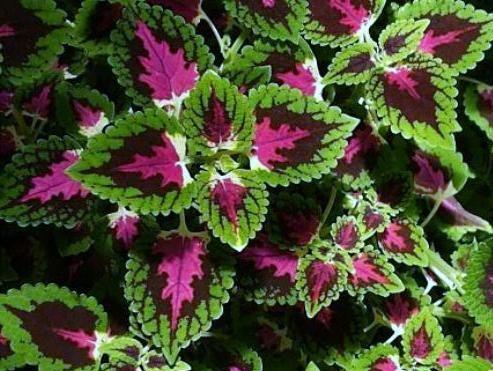
Coleus prefers bright sunlight. If the leaves are bright in color with a lot of bright tones (red, white, light pink), then they can even tolerate direct sunlight; if there are green tones, then it is better to protect them from such exposure.
In conditions home grown It is better to abandon window sills on the north side. If too much light falls on the flower, the color may fade slightly; this phenomenon is most often observed in the spring and summer. Coleus must be gradually accustomed to the sun's rays, exposing it to the sun for several hours a day, otherwise there is a risk of getting burned.
The air temperature in summer should be between 15-25 degrees; if it is too hot, the leaves may wilt. In winter, the ambient temperature can be up to 22 degrees; if it is too cold, the plant will die.
During the active growth period, that is, from spring to autumn, moderate watering is provided as the outer layer of soil dries. The water should be settled and at room temperature. In winter, the plant is also watered; the soil should not be dry. If the coleus does not receive moisture, the flower becomes weak and lethargic.If the air temperature is low, then reduce the amount of watering.
It is important to ensure high air humidity. If it is not possible to install a humidifier, then the coleus should be constantly sprayed with settled water. For the winter, it is best to place the flower pot in the kitchen, as it is warmer and more humid there.
Don't forget about fertilizing. In spring and summer, mineral or organic fertilizers are applied, with preference given to potassium fertilizers. In autumn and winter, fertilizers are applied no more than once a month.
Propagation by cuttings and seeds
Coleus is propagated by both seeds and cuttings. Preference is given to the second method, as it helps preserve the decorative appearance of the leaves.
Cuttings are carried out from February to May. The cuttings are placed in sand in boxes. Rooting occurs quickly, within a week or two. To transplant cuttings, you need to prepare 9-centimeter pots. So far, the composition of the soil is similar to that of diving soil.
To achieve splendor and branching of the subshrub, pinch the top. Caring for seedlings is not difficult. Watering should be moderate, the room should be well ventilated, and the ambient temperature should be no more than 20 degrees. The window sill should be on the sunny side, but the young plant should not be exposed to direct sunlight.
After three months, the coleus grows to the size of an adult plant. Now that the shoots are branched and the leaves are large, you can choose a pot large sizes.
Growing coleus from seeds is a little more difficult. The seeds themselves are quite small. Sowing is done in bowls from February to April, the seeds are sprinkled with sand.
The room temperature should be kept at 20-22 degrees.Shoots will appear in two to three weeks. Then the seedlings are transferred into pots into the soil, which consists equally of sand, turf, peat and leaf.
The seedlings are transplanted into 7 cm pots in the same soil composition when the first leaves appear. After a month, the size of the pot can be increased by several centimeters. To make the plant more branched, it needs to be pinched. After six months, the plant will be almost like an adult.
For the intricacies of choosing coleus, watch the video:
Interesting information about the vegetable garden

